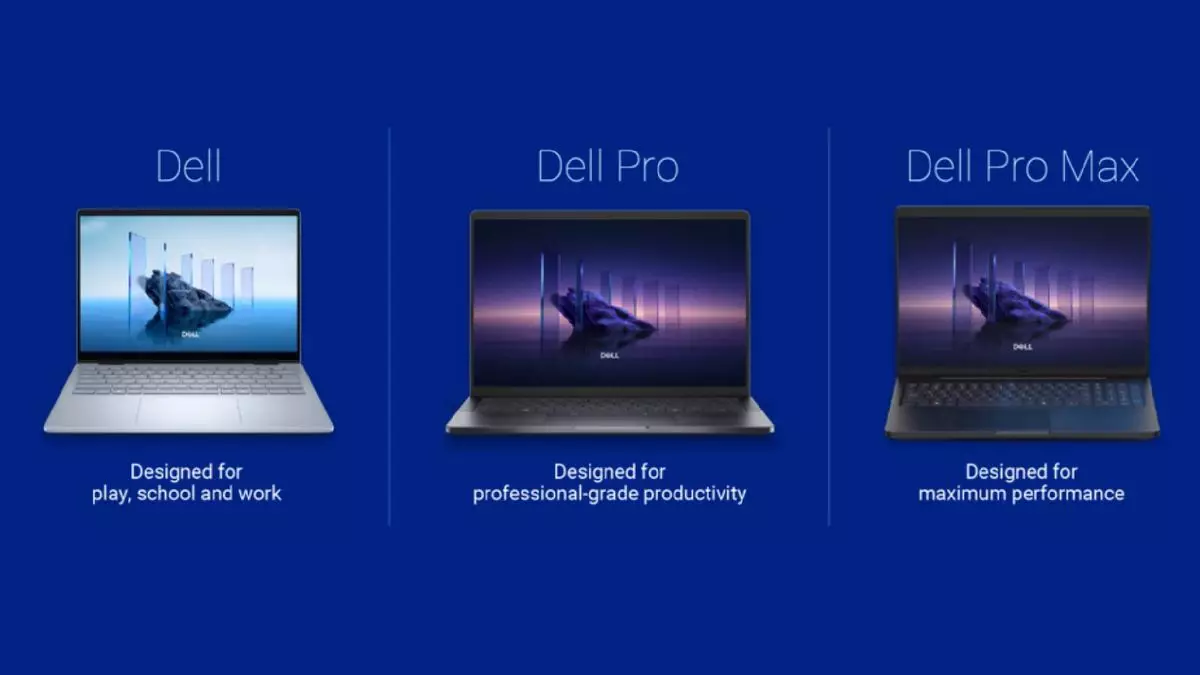In a move that signifies its awareness of consumer confusion, Dell Technologies has announced a rebranding initiative aimed at simplifying its product offerings. The Texas-based company has made the decision to streamline its core PC categories into three distinct tiers: Dell, Dell Pro, and Dell Pro Max. This shift not only indicates a calculated attempt to modernize the brand but also reflects a growing understanding of consumer needs in an ever-evolving tech landscape.
A New Hierarchy of Products
Dell’s decision to consolidate its branding into three main categories represents a renewed effort to create clarity for consumers. The entry-level category, simply titled “Dell,” will cater to consumers looking for devices suitable for educational use, general work, and leisure activities. This move effectively replaces the previous Inspiron brand, which had lost its appeal over time. The middle tier, known as Dell Pro, is targeted at professionals requiring enhanced productivity features, while the top tier, Dell Pro Max, promises cutting-edge performance for power users seeking optimal capabilities in their computing tasks.
The reorganization also allows Dell to maintain a clean and cohesive brand structure that is easier for consumers to navigate. With an estimated 74% of potential buyers opting out of technology purchases due to overwhelming choices, Dell’s streamlined hierarchy could effectively reduce decision fatigue. This rebranding not only positions Dell to capture the attention of consumers but also strives to enhance the purchasing experience, allowing buyers to swiftly identify the product that best meets their requirements.
Alienware and Brand Identity
Despite the significant restructuring, Dell’s popular gaming subsidiary, Alienware, will continue to exist as a separate entity within the tech giant’s offerings. Given Alienware’s strong brand recognition in the gaming community, Dell’s decision to retain this sub-brand aligns with maintaining a unique identity catering specifically to gaming enthusiasts. This distinction is crucial; while Dell aims to dominate the broader consumer and professional markets, Alienware can continue to flourish in the specialized gaming sector.
This separation of identities reflects Dell’s understanding of different market segments. By differentiating between casual consumers and high-performance gamers, Dell can tailor its marketing strategies and product features to meet the specific needs of diverse user groups.
Dell’s new branding initiative goes hand-in-hand with its ongoing commitment to innovation and technology. The company has been vocal about its integration of AI capabilities into its devices, an aspect that many competitors are also exploring. The new Dell Plus lineup will feature laptops powered by Intel’s Core Ultra Series 2 processors, alongside AMD and Qualcomm options, catering to an audience that values both performance and cutting-edge technology.
As Dell rolls out its new models, it aims to position itself as a frontrunner in both consumer and professional markets, ensuring that its devices meet the demands of today’s tech-savvy users. The rollout is already underway, with the Dell Pro series launching immediately and the Dell Plus series expected to be available soon at a competitive starting price of $999. Meanwhile, the highly anticipated Dell Pro Max laptops promise to deliver uncompromising performance, though their release date remains pending.
Interestingly, Dell’s rebranding strategy is reminiscent of Apple’s approach, which has garnered praise for its straightforward product categorization. With terms like “Pro” and “Pro Max” echoing Apple’s product line discussions, Dell may be attempting to capitalize on a familiar nomenclature that conveys a sense of reliability and high-quality performance. This decision may be strategic, as consumers often gravitate towards brands that present clear and relatable product tiers.
While this branding shift is a much-needed evolution for Dell, it also highlights a challenge within the broader tech landscape: the need for simplicity amidst an array of complex product offerings. As companies rush to innovate and create diverse products, the risk of alienating consumers with convoluted branding schemes becomes increasingly prominent.
With its new branding initiative, Dell positions itself to better serve the needs of modern consumers while addressing the hazards of product overload. By simplifying its categories into three easily understandable tiers, Dell not only enhances its image but also strengthens its connection with customers. As the tech giant gears up to introduce innovative products across these tiers, the focus on user-centric design and experience is evident—a move that could redefine how consumers perceive and interact with the Dell brand in the years to come.


Leave a Reply